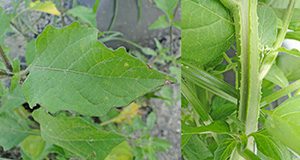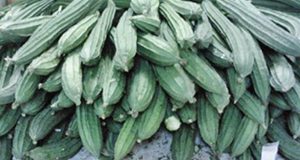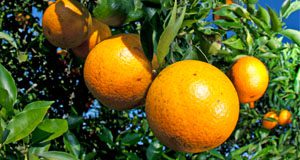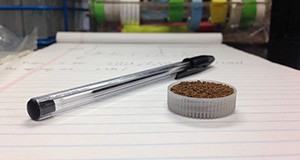This three-page fact sheet describes the biology and management of American black nightshade, explaining how to control for it in tomato and pepper, cucurbits, and strawberry. Written by Nathan S. Boyd, Shawn Steed, Chris Marble, and Andrew MacRae and published by the Horticultural Sciences Department.
http://edis.ifas.ufl.edu/hs1176
Tag: Horticultural Sciences Department
Luffa: an Asian Vegetable Emerging in Florida
Luffa is the genus name of several tropical and subtropical plants in the cucumber family. Alternatively spelled “Loofa” or “Loofah,” the name is derived from the plant’s use as a material for sponges and dish cloths for bathing and cleaning dishes. This six page fact sheet describes the two types of Luffa, how to cultivate them, and what they can be used for. Written by Yucong Xie, Guodong Liu, Yuncong Li, and Kati Migliaccio and published by the Horticultural Sciences Department.
http://edis.ifas.ufl.edu/hs1285
Summer Squash Production in Miami-Dade County, Florida
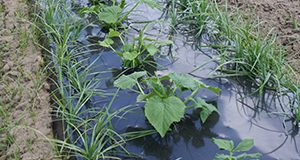
Summer squash is an important vegetable crop in Miami-Dade County. It is grown annually on about 6,000 acres and sold nationwide during the winter in the fresh market. This 16-page fact sheet describes the varieties of summer squash, land preparation and transplanting, what fertilizer to use, irrigation and freeze protection, disease management, insect management, weed management, harvest, and crop rotation. Written by D. Seal, S. Zhang, M. Ozores-Hampton, P. Dittmar, Y. Li, W. Klassen, Q. Wang, and T. Olczyk and published by the Horticultural Sciences Department.
http://edis.ifas.ufl.edu/tr012
Citrus Nutrition UF/IFAS Grower Trials (Pamphlet)
Interested in learning more about citrus nutrition grower trials? This two-page pamphlet provides information on the goals, objectives, benefits, and considerations of the trials as well as specific information about trials being held from 2015-2017. The pamphlet also contains a sign up form for the trials. Written by Tripti Vashisth and Jamie D. Burrow and published by the Horticultural Sciences Department.
http://edis.ifas.ufl.edu/hs1283
Creciendo Papas en el Jardín de su Hogar en la Florida
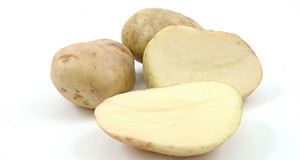
The Irish potato is a cool-season crop. A recently grown and harvested potato exhibits different flavor profiles from one that has been in storage or on a grocery shelf for an extended period. For example, in storage, the starches in potatoes convert to sugars, resulting in a less desirable texture and taste. “New” potato flavor can be achieved in the home garden by following a few growing recommendations. This is ten-page fact sheet is the Spanish language version of HS933 Growing Potatoes in the Florida Home Garden. Written by Christian T. Christensen, Joel Reyes-Cabrera, Lincoln Zotarelli, Wendy J. Dahl, Doug Gergela, Jeffery E. Pack, James M. White, and Chad M. Hutchinson.
http://edis.ifas.ufl.edu/hs1282
Pond Apple: A Tree Species Adapted to Salt Stresses
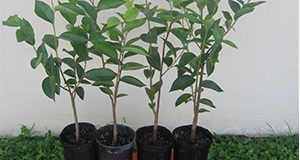
Soil salinity is a naturally ocurring problem for growers, gardeners, and homeowners in Florida. As sea-levels rise, seawater intrusion causes salt stress to plants grown in coastal lowland areas. This three-page fact sheet introduces a salt-tolerant species, pond apple (Annona glabra L.), which has great potential to be used in high-salinity coastal landscapes. Written by Guodong Liu, Yuncong Li, Kimberly Moore, and Kim Gabel and published by the Horticultural Sciences Department.
http://edis.ifas.ufl.edu/hs1281
How to Chemigate Salinity-Stressed Plants with Hydrogen Peroxide to Increase Survival and Growth Rates
Man-made activities can induce climate change and global sea-level rise, posing threats to the survival and growth of coastal vegetation in Florida. This three-page fact sheet explains how to ensure plant survival and facilitate the growth of coastal vegetation threatened by sea-level rise and the resulting oxygen deficiencies and saline stresses. Written by Guodong Liu, Yuncong Li, Kimberly Moore, Kim Gabel, Lei Wu, and Rafael Muñoz-Carpena, and published by the Horticultural Sciences Department.
http://edis.ifas.ufl.edu/hs1280
Leafy Greens in Hydroponics and Protected Culture for Florida

Leafy greens are some of the top “powerhouse” fruits and vegetables. They are also becoming increasingly more popular for consumers. This seven-page fact sheet is designed to aid Florida hydroponic and/or other protected culture growers who are seeking appropriate cultivars of the leafy greens group. The article covers spinach, Swiss chard, kale, collard greens, mustard greens, and Asian greens. Written by Natalie B. Parkell, Robert C. Hochmuth, and Wanda L. Laughlin and published by the Horticultural Sciences Department.
http://edis.ifas.ufl.edu/hs1279
Tong Hao: an Asian Vegetable Emerging in Florida
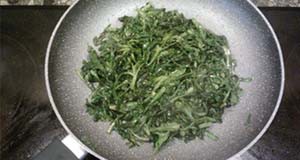
Tong Hao (Glebionis coronaria) is a member of the daisy family and therefore a relative of lettuce. It is an important vegetable in Asian communities. Grown in China for more than 900 years, Tong Hao is a branched annual leafy herb that can be cooked and eaten. This four-page fact sheet provides background information about Tong Hao, including information on growing, harvesting, and cooking it. Written by Guodong Liu, Qingren Wang, Bonnie Wells, Yuncong Li, and David Dinkins, and published by the Horticultural Sciences Department.
http://edis.ifas.ufl.edu/hs1276
Potato Vine Killing or Desiccation

Proper tuber maturity at harvest is an important factor in producing high-quality fresh-market potatoes. Tuber maturity is generally recognized as an important determinant of storage ability and cooking quality. Maturation can be artificially induced by killing the potato vines prior to harvest. This will benefit tuber appearance, limit tuber size, and improve tuber release from the vine. This four-page fact sheet describes the importance of tuber maturation, potato vine killing timing and available methods, and how to determine when to vine kill and when to harvest after vine kill. Written by Lincoln Zotarelli, Steven Sargent, Peter Dittmar, and Mildred Makani, and published by the Horticultural Sciences Department.
http://edis.ifas.ufl.edu/hs181
Suggested Weed Control Programs for Citrus
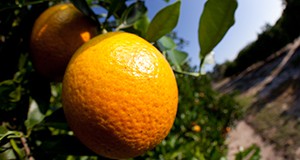
Weed management is an important component of citrus production. The selection and implementation of a weed management program can lead to both economic and environmental returns. This three-page fact sheet details how to manage weeds in both young and mature groves, the differences in weed control programs between interior areas and coastal or flatwoods areas, how to control weeds after a freeze, and common ways that herbicides are misused. Written by Stephen H. Futch and Brent Sellers, and published by the Horticultural Sciences Department.
http://edis.ifas.ufl.edu/ch084
Growing Plums in Florida
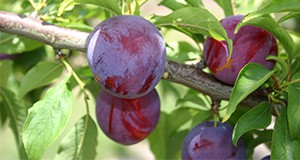
Plums could be a potential crop for growers and homeowners in Florida and other mild winter areas throughout the Gulf coast, but many plum varieties will not grow well enough in Florida to produce fruit. In response to this need, the University of Florida has developed cultivars that improve the potential for growing plums in Florida. This twelve-page fact sheet provides information for growing plums in Florida including information about chilling hours, pollination and fruit set, fruit harvesting, yields, as well as information about the plum cultivars adapted to grow in Florida. Written by M. Olmstead, E.P. Miller, P.C. Andersen, and J.G. Williamson, and published by the Horticultural Sciences Department.
http://edis.ifas.ufl.edu/hs250
Citrus Reset Management
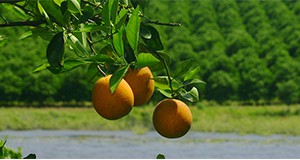
Replacement of dead and diseased trees in Florida citrus groves has always been an important part of citrus production. Today, tree replacement is more important than ever since overhead and production costs are escalating and a full stand of productive trees is essential to maximize production and profits. In more recent times, Huanglongbing (HLB), or citrus greening, has accelerated tree loss rates as well as the ability for growers to bring young citrus trees into production. This five-page fact sheet discusses a wide range of techniques for providing young tree care. Many of these should prove useful to Florida citrus growers confronted with the problem of managing resets. Written by Stephen H. Futch, and published by the Horticultural Sciences Department.
http://edis.ifas.ufl.edu/ch025
Dooryard Citrus Production: Asiatic Citrus Canker Disease
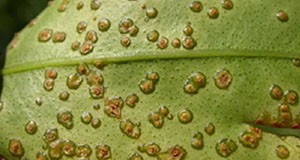
Asiatic citrus canker is a bacterial disease of citrus that causes necrotic lesions on leaves, stems, and fruit of infected trees. Severe cases can cause defoliation, premature fruit drop, twig dieback, and general tree decline.This eight-page fact sheet explains the history of citrus canker in Florida, describes the symptoms of citrus canker, and details how to manage the spread of citrus canker disease by preventing infection and controlling existing infections. Written by Megan M. Dewdney, Jamie D. Burrow, James H. Graham, Timothy M. Spann, and Ryan A. Atwood, and published by the Horticultural Sciences department.
http://edis.ifas.ufl.edu/pp323
Determination of Carbonate Concentrations in Calcareous Soils with Common Vinegar Test
When raising crops on calcareous soils, growers need to know how much calcium carbonate is in the soil before they can employ any management practices. Growers can test the level of carbonate in their soils using store-bought vinegar and other household supplies. This 3-page fact sheet explains the chemistry behind the vinegar test and instructions for performing the test and interpreting the results. Written by Qiang Zhu, Monica Ozores-Hampton, and Yuncong Li, and published by the UF Department of Horticultural Sciences, June 2015.
http://edis.ifas.ufl.edu/hs1262
Water and Nutrient Management Guidelines for Greenhouse Hydroponic Vegetable Production in Florida

Many small farms are implementing greenhouse hydroponic systems. Perhaps the most challenging aspect of crop management for smaller growers is the control of water and nutrient delivery in a soilless media system. This six-page fact sheet focuses on relatively inexpensive strategies to help small growers know both when to start irrigation events and how long to run a single event when growing in soilless media. Written by Robert C. Hochmuth, Natalie B. Parkell, Wanda L. Laughlin, and Sean C. Rider, and published by the Horticultural Sciences Department.
http://edis.ifas.ufl.edu/hs1274
Implementing the Four Rs (4Rs) in Nutrient Stewardship for Tomato Production
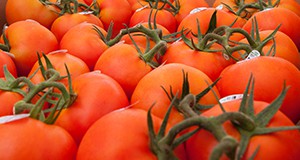 Fertilization plays a critical role in tomato production across the state of Florida. However, appropriate fertilization management depends on four major components (4Rs): right source, right rate, right placement, and right timing. Farming practices that follow the 4Rs can provide nutrients for optimal tomato productivity while minimizing the risk of nutrient losses and adverse environmental effects, both of which are important to the development of agricultural sustainability. This 6-page fact sheet discusses the 4Rs as well as conventional dry source fertilizers, controlled-release or slow-release source fertilizers, and liquid source fertilizers. Written by Qingren Wang, Guodong Liu, Kelly Morgan, and Yuncong Li, and published by the UF Department of Horticultural Sciences, October 2015.
Fertilization plays a critical role in tomato production across the state of Florida. However, appropriate fertilization management depends on four major components (4Rs): right source, right rate, right placement, and right timing. Farming practices that follow the 4Rs can provide nutrients for optimal tomato productivity while minimizing the risk of nutrient losses and adverse environmental effects, both of which are important to the development of agricultural sustainability. This 6-page fact sheet discusses the 4Rs as well as conventional dry source fertilizers, controlled-release or slow-release source fertilizers, and liquid source fertilizers. Written by Qingren Wang, Guodong Liu, Kelly Morgan, and Yuncong Li, and published by the UF Department of Horticultural Sciences, October 2015.
http://edis.ifas.ufl.edu/hs1269
Bitter Melon: An Asian Vegetable Emerging in Florida
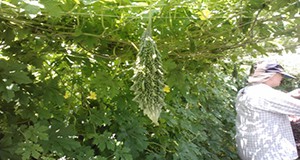 Bitter melon is a tropical and subtropical vegetable crop with long climbing vines which is widely cultivated in Asia, Africa, and the Caribbean. The unripe fruit is used as a vegetable with a pleasantly bitter taste. This 7-page fact sheet provides an overview of this plant as well as recommendations for individuals in Florida who are interested in growing it. Written by Guodong Liu, Qingren Wang, Yuncong Li, David Dinkins, Bonnie Wells, and Yuqi Cui, and published by the UF Department of Horticultural Sciences, December 2015.
Bitter melon is a tropical and subtropical vegetable crop with long climbing vines which is widely cultivated in Asia, Africa, and the Caribbean. The unripe fruit is used as a vegetable with a pleasantly bitter taste. This 7-page fact sheet provides an overview of this plant as well as recommendations for individuals in Florida who are interested in growing it. Written by Guodong Liu, Qingren Wang, Yuncong Li, David Dinkins, Bonnie Wells, and Yuqi Cui, and published by the UF Department of Horticultural Sciences, December 2015.
http://edis.ifas.ufl.edu/hs1271
Tomato Cultivar Selection Considerations for Open-Field and Protected Culture in North Florida
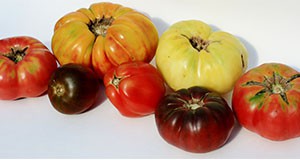
Tomatoes represent one of the most popular vegetables grown in protected culture such as greenhouses, high tunnels, or shade houses. Selecting the correct cultivar of tomato is critical and varies depending on the intended season, type of protected structure, training system, expected insect and disease pressure, post-harvest handling techniques, and intended market. This seven-page fact sheet will focus on the key factors affecting the cultivar selection decisions for growing and selling tomatoes in north Florida. Written by Blake R. Thaxton and Robert C. Hochmuth, and published by the Horticultural Sciences Department.
http://edis.ifas.ufl.edu/hs1273
Long Squash: An Asian Vegetable Emerging in Florida
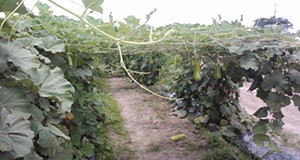 Long squash is an annual, vigorous, and herbaceous crop that was brought to the Americas by Paleoindian populations from Asia before the arrival of Columbus. This 4-page fact sheet provides an overview of this plant as well as recommendations for individuals in Florida who are interested in growing it. Written by Guodong Liu, Yuncong Li, David Dinkins, Bonnie Wells, Qingren Wang, and Yuqi Cui, and published by the UF Department of Horticultural Sciences, December 2015.
Long squash is an annual, vigorous, and herbaceous crop that was brought to the Americas by Paleoindian populations from Asia before the arrival of Columbus. This 4-page fact sheet provides an overview of this plant as well as recommendations for individuals in Florida who are interested in growing it. Written by Guodong Liu, Yuncong Li, David Dinkins, Bonnie Wells, Qingren Wang, and Yuqi Cui, and published by the UF Department of Horticultural Sciences, December 2015.
http://edis.ifas.ufl.edu/hs1272
